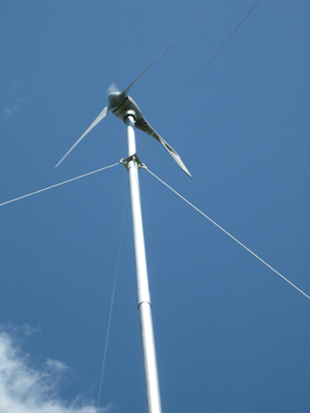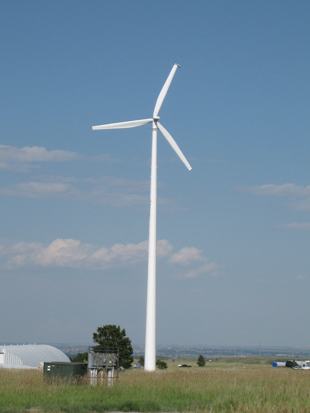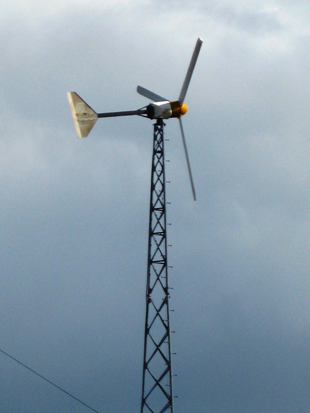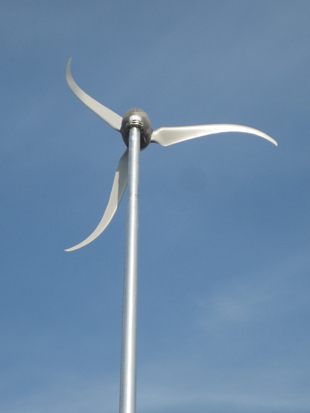G2022
Questions to Ask When Considering a Small Wind Turbine
A guide to what you need to learn before buying a small wind generator system for your home, farm, or business.
F. John Hay, Extension Educator, Bioenergy
Shirley M. Niemeyer, Extension Specialist, Housing and Environment
- Questions to Ask Before You Consider a Small Wind Turbine
- Questions to Ask a Small Wind Turbine Manufacturer
- Questions to Ask a Small Wind Turbine System Dealer or Installer
- Resources
This publication provides questions to ask before buying a small wind generator system for residential, business, or farm use. For purposes of this publication, a small wind generator system refers to systems from micro (tens to hundreds of watts) to 100 kW (Figure 1).
 |
 |
|
| Figure 1. Small wind turbines come in many sizes from micro turbines like the 400 watt turbine above (a) to turbines as large as 50 to 100 kW like the 50 kW turbine pictured above (b). | ||
 |
 |
|
| Figure 2. Two common styles of horizontal axis wind turbines are upwind (using tail to face into the wind, Figure 2a) and downwind (wind blows around tower to reach blades, Figure 2b). | ||
Questions to Ask Before You Consider a Small Wind Turbine
Before you contact a wind turbine manufacturer or distributor, do your homework. The following information and more is needed before you begin exploring a wind system as an option.
- What is your current monthly electrical load in kWh for the building, home, or equipment for which the wind turbine will be used? What is the price of electricity?
- Have you done everything you can to reduce the electrical energy load by
- addressing weatherization, structure efficiency, heat loss and heat gain;
- upgrading equipment, appliances, and lighting efficiencies;
- landscaping, and
- changing current practices?
Remember: Saving a kilowatt-hour is almost always cheaper than producing one. Taking steps to reduce your energy use first will save you money and likely reduce the size of the wind turbine you require.
- Does the property have a good wind resource? What is the average wind speed for your location?
Wind resource maps are one source of this information. (See Resources, Nebraska Energy Office link to download maps.) A Class 2 zone (average wind speeds at 33 feet of 9.8 to 11.5 miles per hour) or better is generally needed. Terrain, buildings, and other factors also affect wind at the particular site. In general, the more exposed or open, the better.
- What is the size of your property or site where the wind turbine will be located?
Generally, one or more acres are needed for turbine towers with support cables (also known as guy wires). One-half acre may be enough for smaller wind systems.
- What are the local or county zoning codes or covenants?
Local zoning codes or covenants may restrict the use of wind generators or tall structures.
- Do federal, state, or local programs offer incentives for small wind systems? Are you eligible for those incentives?
For more information about state and federal incentives, see the online Database of State Incentives for Renewables and Efficiency at http://www.dsireusa.org.
- What are the utility requirements for connecting to the electrical grid?
Contact your local electrical utility office or wholesaler for information.
- How close is the nearest property and neighbor? Have you discussed your interest in installing a wind system with your neighbors?
Noise is one question that may be brought up between neighbors. The noise level of many modern residential turbines is 50-60 decibels (dB). Background noise in a house is close to 50 dB while a tractor with a soundproof cab is close to 85 dB. A visit to an existing small wind turbine site to experience the noise level could be useful.
- How does a small wind system compare in efficiencies to other technologies and efficiency measures such as solar, more efficient equipment and appliances, weatherization, changed practices, and more?
Questions to Ask a Small Wind Turbine Manufacturer
These questions are meant to help you learn details about manufacturers of small wind turbines. Small wind turbine manufacturers should be able to answer these questions, although answers will differ from manufacturer to manufacturer.
- How many of your wind turbines have been installed in the U.S.? Internationally?
- How many of those installed turbines are still in operation today? In the U.S.? Internationally?
- What is the longest time your turbines have been in continuous operation? What is the shortest time? Why?
- How many kWh/year can you realistically expect from your turbine? Can you provide a table of energy production (kWh/year) versus average wind speed? Do you have data to show energy production? If not, why not?
This will not be exact for an individual site, but should be realistic for what the turbine can produce at a specified average wind speed. Remember that putting a turbine at a site with poor wind will create little energy. Average wind speed at your site may be different from the wind map listings, depending on obstacles like trees and buildings.
- Has your turbine been independently tested? Where can I find test results?
Data are important. Field test data are needed for turbines. Field tests represent real life conditions, and not just wind tunnel or vehicle testing. While data from independent testing services are rare, be wary of companies that don’t have any data or field tests of their wind systems.
- What is included with the turbine price?
System configurations vary among manufacturers. When you ask for the cost, also be sure to ask about what the price covers so you can better compare options.
a. What other items are included? Inverters, towers, wiring?
b. Do you manufacture towers? What towers are recommended for your company’s turbines? Why?
c. Are your inverters UL listed?
- Do you offer a warranty? What is included? For how long?
- How do you deal with turbine problems? Defects?
- What is the maximum wind speed your turbines can survive?
All small wind turbines have some type of overspeed protection; many furl or fold themselves in half to avoid high winds.
- Where can I find a dealer/installer/replacement parts?
Questions to Ask a Small Wind Turbine System Dealer or Installer
These questions are meant to help you learn details about small wind turbine dealers and installers. They should be able to answer these questions, although answers will be different among individual dealers, installers, and companies.
- How many turbines have you previously installed? And if none, why?
- Are those turbines still in operation?
a. For how long? And if not, why?
- Can you provide references from past customers?
- How much maintenance is required of a wind turbine?
Any wind turbine system will need maintenance. Often this will include the following: Check and tighten bolts and electrical connections as necessary. Check machines for corrosion and the guy wires for proper tension. Check for and replace any worn leading edge tape on the turbine blades, if appropriate. Replace the turbine blades and/or bearings after 10 years if needed.
- Do you maintain systems after installation? What is the cost of yearly maintenance?
- Where is the nearest repair and service center? How far is someone going to have to travel to service my wind turbine?
- What is the total cost of the small wind turbine system including tower, foundation, turbine, inverter, wiring, installation, and any permits and fees?
- Is my site suitable for a small wind turbine?
Wind turbines need open space for both the tower guy wires in the case of a guyed tower and an open area free of obstacles that cause turbulent wind such as trees and buildings. The general rule for height is 30 feet above anything within 300 feet. The wind is stronger and less turbulent at greater heights, making height an important factor in considering any wind turbine, large or small. If you increase average wind speed by 25 percent from 10 to 12.5 mph, the power in the wind will increase by 95 percent, almost doubling the power. Using short towers or mounting a wind turbine on a roof rarely provides the results expected.
- What size of turbine would be best for my site, load, and goals?
There are many sizes of small wind turbines, from tens of watts to 100 kW, and many types of systems, from battery charging to grid connected. To decide which system is best for you, first determine how you will use the system. Goals could include:
- Generating a portion of my electricity in a “green” manner.
- Lowering monthly electrical bills.
- Living off the grid (not connected to the electricity grid).
- Producing electricity in remote locations where the utility does not provide power.
- How much energy (kWh/year) can I realistically expect from a wind turbine at my site?
Talk with a dealer, installer, small wind site assessor, or a turbine manufacturer for help estimating the amount. (You may have to specify a turbine model.)
Turbines come in many designs. Your choice could be influenced by turbine appearance, turbine size, energy production, noise, and robustness, among other factors. Different designs each have their own appeal. See Figure 2 for two common examples of wind turbine design.
Resources
University of Nebraska–Lincoln Bioenergy http://cropwatch.unl.edu/web/bioenergy/
American Wind Energy Association
- Small wind turbine information: http://www.awea.org/smallwind/
- Small Wind 101: An Overview of Small-Scale Wind Electric Systems http://www.awea.org/pubs/documents/swslides/101-1.htm
- Residential Wind Turbines and Noise, Mick Sagrillo, 2004 http://www.awea.org/smallwind/sagrillo/ms_noise_0404.html
Database of State Incentives for Renewables and Efficiency (DSIRE™) http://www.dsireusa.org
U.S. Department of Energy Efficiency and Renewable Energy http://www.eere.energy.gov/
- Frequently Asked Questions on Small Wind Systems http://www.eere.energy.gov/windandhydro/small_wind_system_faqs.html
- Small Wind Electric Systems: A Nebraska Consumer’s Guide, U.S. Department of Energy, 2007 http://www.windpoweringamerica.gov/small_wind.asp
U.S. Department of Energy National Renewable Energy Lab http://www.nrel.gov/
- National Wind Technology Center http://www.nrel.gov/wind/
- Wind Energy Resource Atlas of the United States http://rredc.nrel.gov/wind/pubs/atlas/
Nebraska Energy Office http://www.neo.ne.gov/renew/wind.htm
U.S. Department of Agriculture – Rural Development http://www.rurdev.usda.gov/rbs/busp/9006grant.htm
U.S. Department of Energy Wind Powering America – Wind Maps and Wind Resource Potential Estimates http://www.windpoweringamerica.gov/wind_maps.asp
Wind Energy Basics: A Guide to Home and Community-Scale Wind Energy Systems by Paul Gipe, 2009. Second Edition, Chelsea Green Publishing Company, White River Junction, Vt.
This publication has been peer reviewed.
Disclaimer Reference to commercial products or trade names is made with the understanding that no discrimination is intended of those not mentioned and no endorsement by University of Nebraska–Lincoln Extension is implied for those mentioned. |
Visit the University of Nebraska–Lincoln Extension Publications Web site for more publications.
Index: Consumer Education
Energy Conservation
Issued May 2010